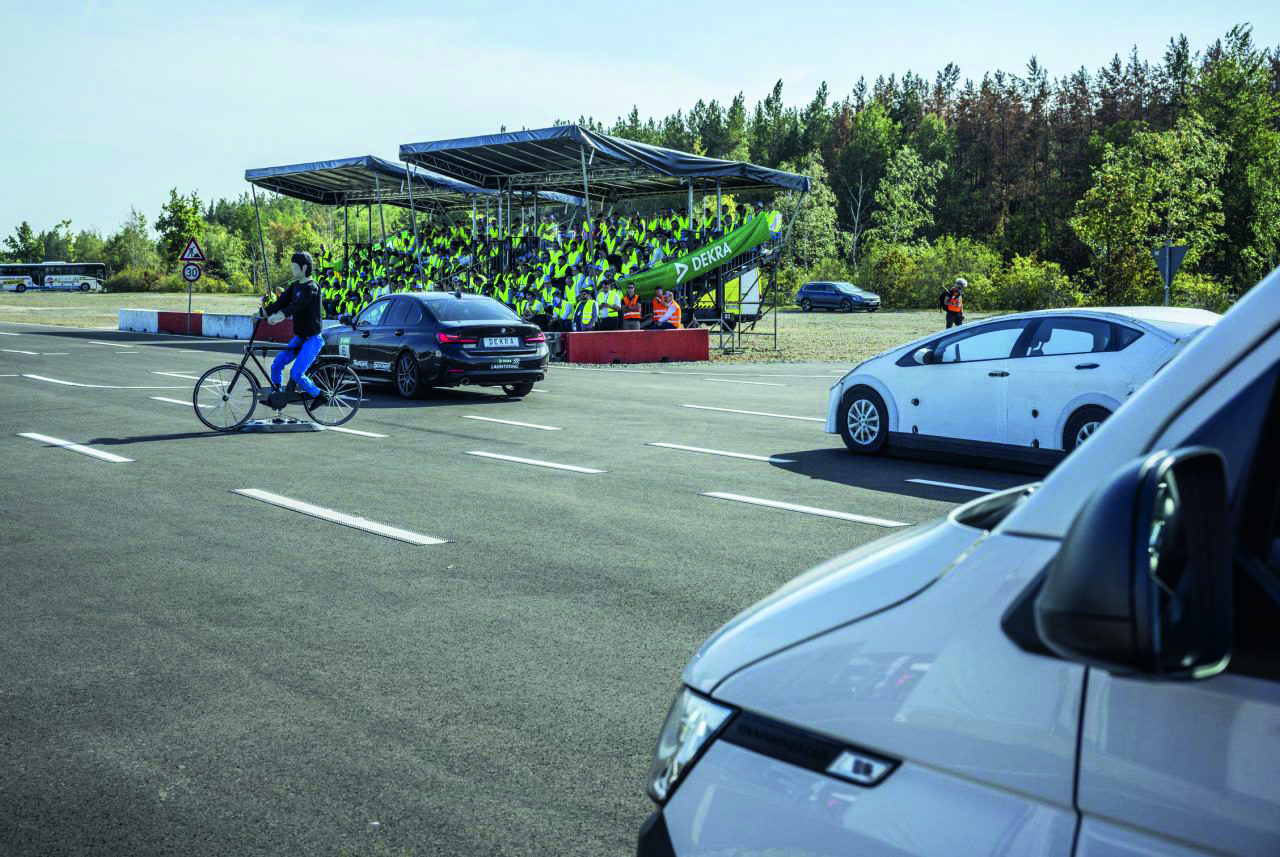 LAURIN-Zwischenbilanz: Schwarmtests auf dem DEKRA Lausitzring. Foto: DEKRA
LAURIN-Zwischenbilanz: Schwarmtests auf dem DEKRA Lausitzring. Foto: DEKRA
The LAURIN research project was launched in May 2022 and is scheduled to run for three years. Consortium leader DEKRA is working on the project together with the Fraunhofer Institute for Transportation and Infrastructure Systems IVI (Dresden), iMAR Navigation GmbH (St. Ingbert), Smart Mobile Labs AG (Munich) and TraceTronic GmbH (Dresden). Its aim is to digitize and automate scenario-based tests at the DEKRA Lausitzring to safeguard automated driving in the future. This involves using so-called swarm tests to simulate traffic scenarios of any complexity in order to expose the vehicles and driving functions to be tested to maximum requirements. The experts recently presented the interim results at an expert conference. A key component of the project is to be able to reproduce practically any real road situation or any scenario on the test tracks at the DEKRA Lausitzring. The basis for this is the existing variety of tracks, above all the new flexible city circuits. “With DEKRA’s expertise and our test equipment, the scenarios can be reproduced reproducibly,” explains consortium leader Felix Kocksch.
REAL ACCIDENT SCENARIOS AS A BASIS
Under the leadership of project partner Fraunhofer IVI, it was demonstrated how accident scenarios, which were elaborately prepared from real police accident reports, can be reconstructed from a database on the test site. “This allows us to test assistance systems or automated driving functions in verifiably critical situations. A real accident can be simulated in the test with a modern assistance system, whereby the system proves that it can prevent the accident,” says Kocksch, describing a specific example shown during the mid-term review. The test sequences can be automated to a high degree. They form the basis for testing future functions of so-called cooperative networked and automated mobility. “One example of this would be how infrastructure such as traffic lights can be integrated into the scenario in the future and send information to vehicles or other road users – for example about traffic light phases or objects detected by sensors in the infrastructure,” says the consortium leader. In the second half of the project, research work in this direction is planned.
SWARM TESTS IN REALITY AND IN THE DIGITAL TWIN
In addition to the test tracks, the test methodology of the swarm test is the second main pillar of the LAURIN research project. The concept has undergone extensive further development since the start of the project. Among other things, the process of precisely digitizing the test site is underway. “The basic survey of the site using high-precision surveying technology has been completed,” explains Kocksch. If a specific scenario – for example in terms of route layout and lane markings – is set up in reality, corresponding HD maps can be created quickly and flexibly from drone photos. The scenarios can thus be carried out both in reality and with the so-called digital twin of the test site. Thanks to the software from project partner TraceTronic, the maneuvers of the moving objects can be easily created in the simulation. “This gives us optimal opportunities to compare the real tests with virtual tests and make them directly comparable,” says the consortium leader. The project also tested a connection for automated test case evaluation.
Another important building block for scenario-based testing in the swarm is the 5G campus network. Large areas of the test site at the DEKRA Lausitzring are already covered by a private 5G network; further expansion is underway. Project partner Smart Mobile Labs is working on configuring the 5G infrastructure to meet requirements. The experts demonstrated how all of this works together at carhs GmbH’s “The ADAS Experience” event at the end of September 2023 with a swarm test involving six participants. This initially included the so-called “vehicle under test”, i.e. the vehicle to be tested with modern assistance systems. In addition, there were two series vehicles controlled by driving robots, a vehicle whose actuators are controlled remotely via electronic signals (“by wire”) and two drive-over platforms that simulated another car and a cyclist with soft targets. “Controlling the interaction of moving objects in the test scenario with pinpoint accuracy and thus making it reproducible is the big challenge, and we have shown in the project that it works,” says Felix Kocksch. To this end, project partner iMAR is further developing its control station solution, which is already being used to centrally orchestrate and monitor all objects. The aim is to ultimately be able to apply the methods being tested in the LAURIN project to swarms of up to twelve objects. In the further course of the research project, the aim is now to further link the individual components developed so far and to transfer them into an integrated overall concept, according to which the highly complex tests for safeguarding automated driving can be carried out in everyday test operations in the future.
A total of around 4.2 million euros will be invested in the LAURIN project. It is being funded by the Federal Ministry for Digital and Transport with a total of 2.45 million euros as part of the mFUND innovation offensive.
Read more articles on the topic of electromobility & autonomous driving in the current issue of eMove360° magazine in german language.